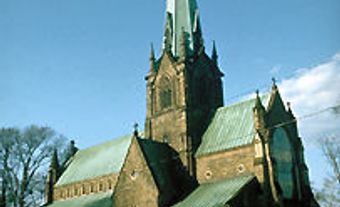
Basilica of St John the Baptist
Visible from everywhere in St. John's, Newfoundland, and, so important in the 19th century, the most striking building as one entered the harbour, the Basilica of St. John the Baptist was built to assert the place and power of Newfoundland's Irish Catholic population. Built between 1841 and 1855, it was a massive undertaking for the size and the prospects of the population. It was built on a height above the occupied section of the town and was not oriented on a liturgically proper axis. These three aspects - size, site and orientation - were all matters of criticism at the time of its construction and are what ensure its prominence in the landscape.
The Basilica was the work of Bishop Michael Anthony Fleming, who, after a long battle with the authorities, acquired the property in 1838. He was then able to encourage the local population to remarkable bursts of work, in which they spent weeks hauling stone and timber to the site. The designer was likely a German architect, M. Schmidt, whose general design was followed even if modifications were made to his floor plan. Distinguished by two towers on the façade, the basilica is cruciform in plan and, when built, was the largest church in North America. The style, Lombard Romanesque, is unusual. There does not appear to be any other example of the style being used for a church as early as this, although it did become common throughout Ireland about 20 years later.
The basilica contains some important works by the Irish sculptor John Hogan, including "The Dead Christ" and memorials to Bishops Scallan and Fleming. In the piazza are three statues by Hogan's contemporary, John Edward Carew. To the east of the basilica are the convents and schools of the Mercy and Presentation orders; to the west are the Palace, the Bishop's Library and St. Bonaventure's College. The whole complex of ecclesiastical buildings creates a remarkably large and intact religious precinct about the basilica.

 Share on Facebook
Share on Facebook Share on X
Share on X Share by Email
Share by Email Share on Google Classroom
Share on Google Classroom


